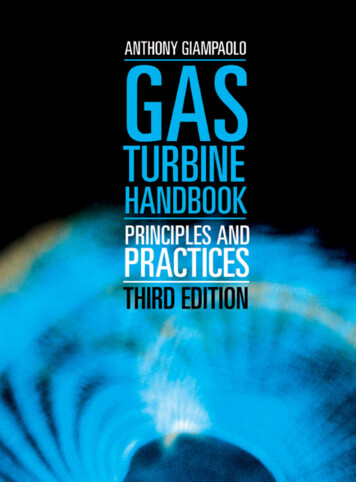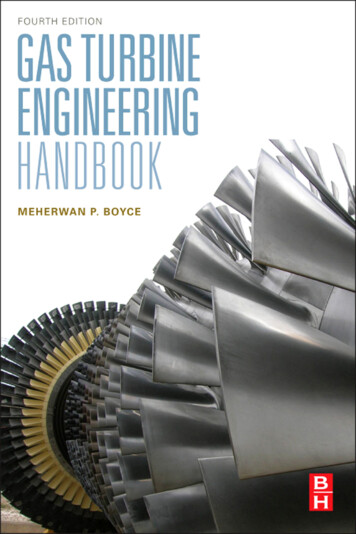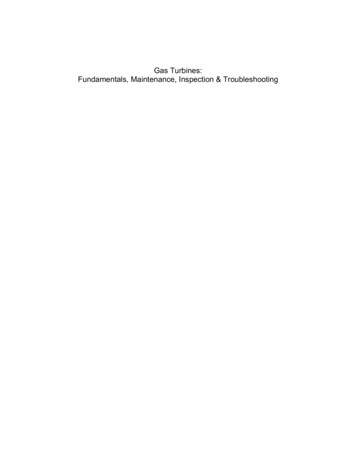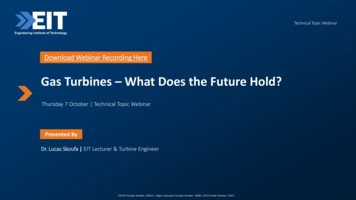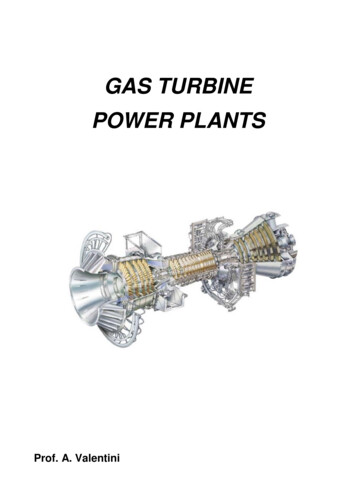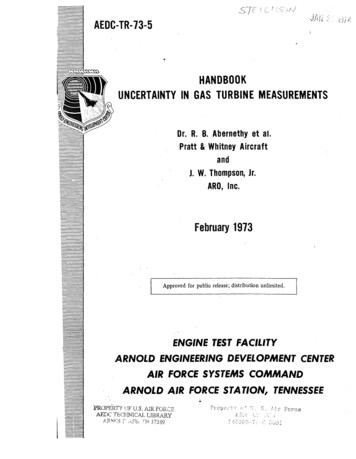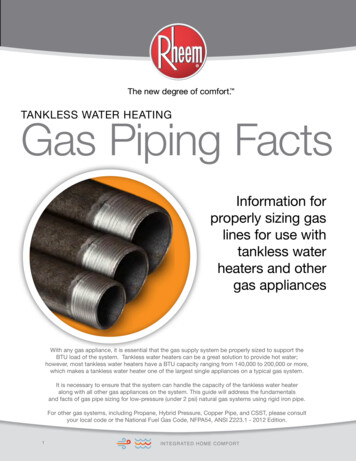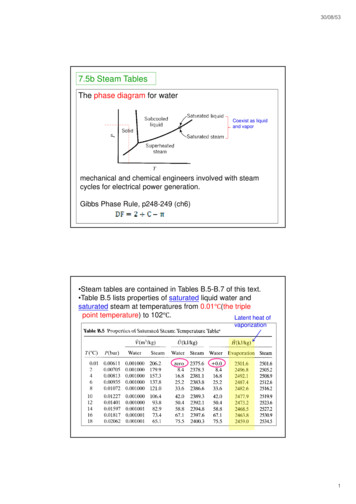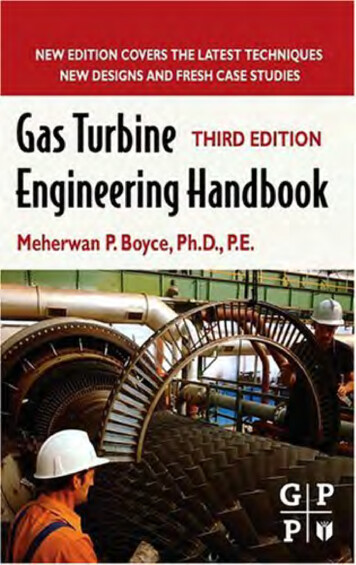
Transcription
Gas TurbineEngineeringHandbookThird EditionMeherwan P. BoyceManaging Partner, The Boyce ConsultancyFellow, American Society of Mechanical EngineersFellow, Institute of Diesel and Gas Turbine Engineers, U.K.BostonOxfordAucklandJohannesburgMelbourneNew Delhi
Gulf Professional Publishing is an imprint of Elsevier30 Corporate Drive, Suite 400, Burlington, MA 01803, USALinacre House, Jordan Hill, Oxford OX2 8DP, UKCopyright 2006, Elsevier Inc. All rights reserved.No part of this publication may be reproduced, stored in a retrieval system, or transmitted in anyform or by any means, electronic, mechanical, photocopying, recording, or otherwise, without theprior written permission of the publisher.Permissions may be sought directly from Elsevier’s Science & Technology RightsDepartment in Oxford, UK: phone: ( 44) 1865 843830, fax: ( 44) 1865 853333,E-mail: permissions@elsevier.com. You may also complete your request on-line via the Elsevierhomepage (http://elsevier.com), by selecting “Support & Contact” then “Copyright and Permission”and then “Obtaining Permissions.”Recognizing the importance of preserving what has been written, Elsevier prints its books onacid-free paper whenever possible.Library of Congress Cataloging-in-Publication DataBoyce, Meherwan P.Gas turbine engineering handbook / Meherwan P. Boyce. – 3rd ed.p. cm.Includes bibliographical references and index.ISBN 0-88415-732-6 (alk. paper)1. Gas-turbines–Handbooks, manuals, etc. I. Title.TJ778 .B67 2001621.43 3–dc212001040520British Library Cataloguing-in-Publication DataA catalogue record for this book is available from the British Library.ISBN 13: 978-0-7506-7846-9ISBN 10: 0-7506-7846-1For information on all Gulf Professional Publishingpublications visit our Web site at www.books.elsevier.com06 07 08 09 1010 9 8 7 6 5 4 3 2 1Printed in the United States of America
To the memory of my father, Phiroz H.J. Boyce
PrefaceGas Turbine Engineering Handbook discusses the design, fabrication, installation, operation, and maintenance of gas turbines. The third edition is not only anupdating of the technology in gas turbines, which has seen a great leap forwardin the 2000s, but also a rewriting of various sections to better answer today’sproblems in the design, fabrication, installation, operation, and maintenance ofgas turbines. The third edition has added a new chapter that examines the casehistories of gas turbines from deterioration of the performance of gas turbines tofailures encountered in all the major components of the gas turbine. The chapter on Maintenance Techniques has been completely rewritten and updated. Therevised chapter deals with Long Term Service Agreements (LTSAs), and specialmaintenance tables have been added so that you can troubleshoot problems ongas turbines that you may encounter.The new advanced gas turbines have firing temperatures of 2600 F (1427 C),and pressure ratios exceeding 40:1 in aircraft gas turbines, and over 30:1 inindustrial turbines. This has led to the rewriting of Chapter 7, to fully understandthe operating mechanics of these high pressure ratio axial-flow compressors.The chapter covers in detail the advent of surge, and describes in great detail thedifferent mechanisms of surge, rotating stall, and choke flow conditions in thecompressor of the gas turbine. Advances in materials and coatings have spurredthis technology, and the new edition has treated this new area in great detail. Theemphasis on low NOx emissions from gas turbines has led to the development ofa new breed of Dry Low NOx combustors, and their problems are dealt with indepth in this new edition. The third edition deals with an upgrade in the designand maintenance of advanced gas turbines and deals with most of the applicablecodes both in the area of performance and mechanical standards.The new edition has been written with the experienced engineer in mind whois working in power plants, and in petrochemical and offshore installations. Thisedition should help him or her understand more clearly problems encountered inthe field, and how to prevent them.The book also provides the basic fluid mechanics and thermodynamics for theyoung engineering graduate or undergraduate student who is being exposed tothe turbomachinery field for the first time. The book is very useful as a textbookfor undergraduate or graduate turbomachinery courses as well as for in-housex
Prefacexicompany training programs related to the petrochemical, power generation, andoffshore industries.The use of gas turbines in the petrochemical, power generation, and offshoreindustries has mushroomed in the past few years. The power industry in the pastten years has embraced the combined cycle power plants, and the new highefficiency gas turbines are at the center of this growth segment of the industry.However, due to the spiraling costs of natural gas, many of these plants designedfor base load service have been cycled on a daily basis from part loads of 50%to full load, and in many cases have had to be shutdown on weekends. The newmaintenance chapters, with their case histories, should be of great assistance tothe engineers in the field who have to operate their plant at other than designconditions of base loaded operation. Investigation of operating these plants onother fuels is also handled in this edition.The book will give the manufacturer a glimpse of some of the problemsassociated with gas turbines in the field and help users to achieve maximumperformance efficiency and high availability of their gas turbines.I have been involved in the research, design, operation, and maintenance ofgas turbines since the early 1960s. I have also taught courses at the graduate andundergraduate level at the University of Oklahoma and Texas A&M University,and now, in general, to the industry. There have been over 4000 students throughmy courses designed for the engineer in the field, representing over 450 companies from around the world. They have used the book, and their comments andmy field troubleshooting experience have been very influential in the updatingof material in this edition. The enthusiasm of the students associated with thesecourses gave me the inspiration to undertake this endeavor. The many coursesI have taught over the past 35 years have been an educational experience forme as well as for the students. The discussions and consultations that resultedfrom my association as a consultant to the power, petrochemical, and aviationindustries with highly professional individuals have been a major contribution toboth my personal and professional life as well as to this new edition of the book.In this edition I have tried to assimilate the subject matter of various papers(and sometimes diverse views) into a comprehensive, unified treatment of gasturbines. Many illustrations, curves, and tables are employed to broaden theunderstanding of the descriptive text. I have provided extensive new charts thatcan be used to diagnose problems. In addition, the references direct you to sourcesof information that will help you investigate and solve your specific problems.I hope that this book will serve as a reference text after it has accomplished itsprimary objective of introducing you to the broad subject of gas turbines.I wish to thank the many engineers whose published work and discussionshave been a cornerstone to this work. The Turbomachinery Symposium, of whichI had the distinct honor and pleasure of founding and chairing for eight years,
xiiPrefaceand the proceedings of the Symposium, have contributed many interesting technology issues from both a design and maintenance point of view. A specialthanks also goes to my colleagues on the Advisory Committee of the TexasA&M University Turbomachinery Symposium, of which I have been a memberfor 34 years, and to Dr. Dara Childs, who is now the chairman of the AdvisoryCommittee.I wish to acknowledge and give a very special thanks to my wife, Zarine, forher readiness to help and her constant encouragement throughout this project.A special thanks also to my secretary and executive assistant Donna Masters forthe hours she has spent working with me on this new edition.I sincerely hope that this new edition will be educational and will enable youto get a new updated look at gas turbine technology and enhanced maintenancepractices, while retaining the basic theory that governs the development of gasturbines.Meherwan P. BoyceHouston, TexasSeptember 2005
Preface to the SecondEditionGas Turbine Engineering Handbook discusses the design, fabrication, installation, operation, and maintenance of gas turbines. The second edition is not onlyan updating of the technology in gas turbines, which has seen a great leap forwardin the 1990s, but also a rewriting of various sections to better answer today’sproblems in the design, fabrication, installation, operation, and maintenance ofgas turbines. The new advanced gas turbines have firing temperatures of 2600 F(1427 C), and pressure ratio’s exceeding 40:1 in aircraft gas turbines, and over30:1 in industrial turbines. Advances in materials and coatings have spurred thistechnology, and the new edition has treated this new area in great detail. Theemphasis on low NOx emissions from gas turbines has led to the developmentof a new breed of dry low NOx combustors, which are dealt with in depth in thisnew edition. The second edition deals with an upgrade of most of the applicablecodes both in the area of performance and mechanical standards.The book has been written to provide an overall view for the experienced engineer working in a specialized aspect of the subject and for the young engineeringgraduate or undergraduate student who is being exposed to the turbomachineryfield for the first time. The book will be very useful as a textbook for undergraduate turbomachinery courses as well as for in-house company training programsrelated to the petrochemical, power generation, and offshore industries.The use of gas turbines in the petrochemical, power generation, and offshoreindustries has mushroomed in the past few years. In the past 10 years, the powerindustry has embraced the Combined Cycle Power Plants and the new high efficiency gas turbines are at the center of this growth segment of the industry.This has also led to the rewriting of Chapters 1 and 2. It is to these users andmanufacturers of gas turbines that this book is directed. The book will give themanufacturer a glimpse of some of the problems associated with his equipmentin the field and help the user to achieve maximum performance efficiency andhigh availability of his gas turbines.I have been involved in the research, design, operation, and maintenance ofgas turbines since the early 1960s. I have also taught courses at the graduate andundergraduate level at the University of Oklahoma and Texas A&M University,and now, in general, to the industry. There have been over 3,000 students throughmy courses designed for the engineer in the field representing over 400 companiesxiii
xivPreface to the Second Editionfrom around the world. Companies have used the book, and their commentshave been very influential in the updating of material in the second edition. Theenthusiasm of the students associated with these courses gave me the inspirationto undertake this endeavor. The many courses I have taught over the past 25 yearshave been an educational experience for me as well as for the students. TheTexas A&M University Turbomachinery Symposium, which I had the privilegeto organize and chair for over eight years and be part of the Advisory Committeefor 30 years, is a great contributor to the operational and maintenance sections ofthis book. The discussions and consultations that resulted from my associationwith highly professional individuals have been a major contribution to both mypersonal and professional life as well as to this book.In this book, I have tried to assimilate the subject matter of various papers(and sometimes diverse views) into a comprehensive, unified treatment of gasturbines. Many illustrations, curves, and tables are employed to broaden theunderstanding of the descriptive text. Mathematical treatments are deliberatelyheld to a minimum so that the reader can identify and resolve any problemsbefore he is ready to execute a specific design. In addition, the references directthe reader to sources of information that will help him to investigate and solvehis specific problems. It is hoped that this book will serve as a reference textafter it has accomplished its primary objective of introducing the reader to thebroad subject of gas turbines.I wish to thank the many engineers whose published work and discussionshave been a cornerstone to this work. I especially thank all my graduate students and former colleagues on the faculty of Texas A&M University withoutwhose encouragement and help this book would not be possible. Special thanksgo to the Advisory Committee of the Texas A&M University TurbomachinerySymposium and Dr. M. Simmang, Chairman of the Texas A&M UniversityDepartment of Mechanical Engineering, who were instrumental in the initiationof the manuscript.I wish to acknowledge and give special thanks to my wife, Zarine, for herreadiness to help and her constant encouragement throughout this project.I sincerely hope that this new edition will be as interesting to read as it wasfor me to write and that it will be a useful reference to the fast-growing field ofturbomachinery.Finally, I would like to add that the loss of my friend and mentor Dr. C.M.Simmang who has written the foreword to the first edition of this book is a deeploss not only to me but also to the engineering educational community and tomany of his students from Texas A&M University.Meherwan P. BoyceHouston, Texas
Preface to the First EditionGas Turbine Engineering Handbook discusses the design, fabrication, installation, operation, and maintenance of gas turbines. The book has been writtento provide an overall view for the experienced engineer working in a specializedaspect of the subject and for the young engineering graduate or undergraduatestudent who is being exposed to the turbomachinery field for the first time. Thebook will be very useful as a textbook for undergraduate turbomachinery coursesas well as for in-house company training programs related to the petrochemical,power generation, and offshore industries.The use of gas turbines in the petrochemical, power generation, and offshoreindustries has mushroomed in the past few years. It is to these users and manufacturers of gas turbines that this book is directed. The book will give themanufacturer a glimpse of some of the problems associated with his equipmentin the field and help the user to achieve maximum performance efficiency andhigh availability of his gas turbines.I have been involved in the research, design, operation, and maintenance ofgas turbines since the early 1960s. I have also taught courses at the graduate andundergraduate level at the University of Oklahoma and Texas A&M University,and now, in general, to the industry. The enthusiasm of the students associatedwith these courses gave me the inspiration to undertake this endeavor. The manycourses I have taught over the past 15 years have been an educational experiencefor me as well as for the students. The Texas A&M University TurbomachinerySymposium, which I had the privilege to organize and chair for seven years,is a great contributor to the operational and maintenance sections of this book.The discussions and consultations that resulted from my association with highlyprofessional individuals have been a major contribution to both my personal andprofessional life as well as to this book.In this book, I have tried to assimilate the subject matter of various papers(and sometimes diverse views) into a comprehensive, unified treatment of gasturbines. Many illustrations, curves, and tables are employed to broaden theunderstanding of the descriptive text. Mathematical treatments are deliberatelyheld to a minimum so that the reader can identify and resolve any problemsbefore he is ready to execute a specific design. In addition, the references directthe reader to sources of information that will help him to investigate and solvehis specific problems. It is hoped that this book will serve as a reference textxv
xviPreface to the First Editionafter it has accomplished its primary objective of introducing the reader to thebroad subject of gas turbines.I wish to thank the many engineers whose published work and discussionshave been a cornerstone to this work. I especially thank all my graduate students and former colleagues on the faculty of Texas A&M University withoutwhose encouragement and help this book would not be possible. Special thanksgo to the Advisory Committee of the Texas A&M University TurbomachinerySymposium and Dr. C.M. Simmang, Chairman of the Texas A&M UniversityDepartment of Mechanical Engineering, who were instrumental in the initiationof the manuscript, and to Janet Broussard for the initial typing of the manuscript.Acknowledgment is also gratefully made of the competent guidance of WilliamLowe and Scott Becken of Gulf Publishing Company. Their cooperation andpatience facilitated the conversion of the raw manuscript to the finished book.Lastly, I wish to acknowledge and give special thanks to my wife, Zarine, forher readiness to help and her constant encouragement throughout this project.I sincerely hope that this book will be as interesting to read as it was forme to write and that it will be a useful reference to the fast-growing field ofturbomachinery.Meherwan P. BoyceHouston, Texas
Foreword to the First EditionThe Alexandrian scientist Hero (circa 120 B.C.) would hardly recognize themodern gas turbine of today as the outgrowth of his aeolipile. His device producedno shaft work—it only whirled. In the centuries that followed, the principle ofthe aeolipile surfaced in the windmill (A.D. 900–1100) and again in the poweredroasting spit (1600s). The first successful gas turbine is probably less than acentury old.Until recently, two principal obstacles confronted the design engineer in hisquest for a highly efficient turbine: (1) the temperature of the gas at the nozzleentrance of the turbine section must be high, and (2) the compressor and theturbine sections must each operate at a high efficiency. Metallurgical developments are continually raising inlet temperatures, while a better understanding ofaerodynamics is partly responsible for improving the efficiency of centrifugaland axial-flow compressors and radial-inflow and axial-flow turbines.Today there are a host of other considerations and concerns which confrontdesign and operating engineers of gas turbines. These include bearings, seals,fuels, lubrication, balancing, couplings, testing, and maintenance. Gas TurbineEngineering Handbook presents necessary data and helpful suggestions to assistengineers in their endeavors to obtain optimum performance for any gas turbineunder all conditions.Meherwan Boyce is no stranger to gas turbines. For more than a decade hehas been highly active with the techniques of turbomachinery in industry, academics, research, and publications. The establishment of the annual Texas A&MUniversity Turbomachinery Symposium can be numbered among his major contributions to the field of turbomachinery. Dr. Boyce subsequently directed thefollowing seven prior to forming his own consulting and engineering company.The tenth symposium was held recently and attracted more than 1,200 engineersrepresenting many different countries.This important new handbook comes to us from an experienced engineer at amost opportune time. Never has the cost of energy been greater, nor is there apromise that it has reached its price ceiling. Dr. Boyce is aware of these concerns,and through this handbook he has provided the guide and means for optimumuse of each unit of energy supplied to a gas turbine. The handbook should find itsxvii
xviiiForeword to the First Editionplace in all the reference libraries of those engineers and technicians who haveeven a small responsibility for design and operation of gas turbines.Clifford M. SimmangDepartment of Mechanical EngineeringTexas A&M UniversityCollege Station, Texas
ContentsPreface . . . . . . . . . . . . . . .Preface to the Second EditionPreface to the First Edition . .Foreword to the First Edition .Part I1.x. xiii.xv. xviiDesign: Theory and PracticeAn Overview of Gas Turbines . . . . . . . . . . . . . . . . . . . . . . . . . . . .3Gas Turbine Cycle in the Combined Cycle or Cogeneration Mode. Gas Turbine Performance. GasTurbine Design Considerations. Categories of Gas Turbines. Major Gas Turbine Components. FuelType. Environmental Effects. Turbine Expander Section. Materials. Coatings. Gas Turbine HeatRecovery. Supplementary Firing of Heat Recovery Systems. Bibliography.2Theoretical and Actual Cycle Analysis . . . . . . . . . . . . . . . . . . . . . .57The Brayton Cycle. Actual Cycle Analysis. The Brayton-Rankine Cycle. Summation of CycleAnalysis. A General Overview of Combined Cycle Plants. Compressed Air Energy Storage Cycle.Power Augmentation. Summation of the Power Augmentation Systems. Bibliography.3Compressor and Turbine Performance Characteristics . . . . . . . . . . . 110Turbomachine Aerothermodynamics. The Aerothermal Equations. Efficiencies. DimensionalAnalysis. Compressor Performance Characteristics. Turbine Performance Characteristics. GasTurbine Performance Computation. Bibliography.4Performance and Mechanical Standards . . . . . . . . . . . . . . . . . . . . 139Major Variables for a Gas Turbine Application. Performance Standards. Mechanical Parameters.Application of the Mechanical Standards to the Gas Turbine. Specifications. Bibliography.5Rotor Dynamics . . . . . . . . . . . . . . . . . . . . . . . . . . . . . . . . . . . . 176Mathematical Analysis. Application to Rotating Machines. Critical Speed Calculations for RotorBearing Systems. Electromechanical Systems and Analogies. Campbell Diagram. Bibliography.Part II6Major ComponentsCentrifugal Compressors . . . . . . . . . . . . . . . . . . . . . . . . . . . . . . 219Centrifugal Compressor Components. Centrifugal Compressor Performance. Compressor Surge.Process Centrifugal Compressors. Bibliography.7Axial-Flow Compressors . . . . . . . . . . . . . . . . . . . . . . . . . . . . . . . 274Introduction. Blade and Cascade Nomenclature. Elementary Airfoil Theory. Laminar-Flow Airfoils.Energy Increase. Velocity Triangles. Degree of Reaction. Radial Equilibrium. Diffusion Factor.The Incidence Rule. The Deviation Rule. Compressor Operation Characteristics. Compressor Choke.Compressor Performance Parameters. Performance Losses in an Axial-Flow Compressor. New Developments in Axial-Flow Compressors. Axial-Flow Compressor Research. Compressor Blade Material.Acknowledgments. Bibliography.vii
viii8ContentsRadial-Inflow Turbines . . . . . . . . . . . . . . . . . . . . . . . . . . . . . . . . 336Description. Theory. Turbine Design Considerations. Losses in a Radial-Inflow Turbine. Performanceof a Radial-Inflow Turbine. Bibliography.9Axial-Flow Turbines . . . . . . . . . . . . . . . . . . . . . . . . . . . . . . . . . . 354Turbine Geometry. Impulse Turbine. The Reaction Turbine. Turbine Blade Cooling Concepts. TurbineBlade Cooling Design. Cooled-Turbine Aerodynamics. Turbine Losses. Bibliography.10Combustors . . . . . . . . . . . . . . . . . . . . . . . . . . . . . . . . . . . . . . . 387Combustion Terms. Combustion. Combustion Chamber Design. Fuel Atomization and Ignition.Typical Combustor Arrangements. Air Pollution Problems. Catalytic Combustion. Bibliography.Part III11Materials, Fuel Technology, and Fuel SystemsMaterials . . . . . . . . . . . . . . . . . . . . . . . . . . . . . . . . . . . . . . . . . 429General Metallurgical Behaviors in Gas Turbines. Gas Turbine Materials. Compressor Blades.Forgings and Nondestructive Testing. Coatings. Bibliography.12Fuels . . . . . . . . . . . . . . . . . . . . . . . . . . . . . . . . . . . . . . . . . . . . 454Fuel Specifications. Fuel Properties. Liquid Fuel Handling and Treatment. Heavy Fuels. Fuel GasHandling and Treatment. Equipment for Removal of Particulates and Liquids from Fuel Gas Systems.Fuel Heating. Cleaning of Turbine Components. Fuel Economics. Operating Experience. Heat Tracingof Piping Systems. Types of Heat-Tracing Systems. Storage of Liquids. Bibliography.Part IV13Auxiliary Components and AccessoriesBearings and Seals . . . . . . . . . . . . . . . . . . . . . . . . . . . . . . . . . . 501Bearings. Bearing Design Principles. Tilting-Pad Journal Bearings. Bearing Materials. Bearingand Shaft Instabilities. Thrust Bearings. Factors Affecting Thrust-Bearing Design. Thrust-BearingPower Loss. Seals. Noncontacting Seals. Mechanical (Face) Seals. Mechanical Seal Selection andApplication. Seal Systems. Associated Oil System. Dry Gas Seals. Bibliography.14Gears . . . . . . . . . . . . . . . . . . . . . . . . . . . . . . . . . . . . . . . . . . . 553Gear Types. Factors Affecting Gear Design. Manufacturing Processes. Installation and InitialOperation. Bibliography.Part V15Installation, Operation, and MaintenanceLubrication . . . . . . . . . . . . . . . . . . . . . . . . . . . . . . . . . . . . . . . . 573Basic Oil System. Lubricant Selection. Oil Sampling and Testing. Oil Contamination. Filter Selection.Cleaning and Flushing. Coupling Lubrication. Lubrication Management Program. Bibliography.16Spectrum Analysis . . . . . . . . . . . . . . . . . . . . . . . . . . . . . . . . . . . 589Vibration Measurement. Taping Data. Interpretation of Vibration Spectra. Subsynchronous VibrationAnalysis Using RTA. Synchronous and Harmonic Spectra. Bibliography.17Balancing . . . . . . . . . . . . . . . . . . . . . . . . . . . . . . . . . . . . . . . . . 615Rotor Imbalance. Balancing Procedures. Application of Balancing Techniques. User’s Guide forMultiplane Balancing. Data Sheet C. Bibliography.18Couplings and Alignment . . . . . . . . . . . . . . . . . . . . . . . . . . . . . . 635Gear Couplings. Metal Diaphragm Couplings. Metal Disc Couplings. Turbomachinery Uprates. ShaftAlignment. Bibliography.
Contents19ixControl Systems and Instrumentation . . . . . . . . . . . . . . . . . . . . . . 664Control Systems. Condition Monitoring Systems. Monitoring Software. Implementation of aCondition Monitoring System. Life Cycle Costs. Temperature Measurement. Pressure Measurement. Vibration Measurement. Auxiliary System Monitoring. The Gas Turbine. Failure Diagnostics.Mechanical Problem Diagnostics. Summary. Bibliography.20Gas Turbine Performance Test . . . . . . . . . . . . . . . . . . . . . . . . . . . 721Introduction. Performance Codes. Flow Straighteners. Gas Turbine Test. Gas Turbine. PerformanceCurves. Performance Computations. Gas Turbine Performance Calculations. Correction Factors forGas Turbines. Vibration Measurement. Emission Measurements. Plant Losses. Bibliography.21Maintenance Techniques . . . . . . . . . . . . . . . . . . . . . . . . . . . . . . . 761Philosophy of Maintenance. Training of Personnel. Tools and Shop Equipment. Gas Turbine Start-up.Redesign for Higher Machinery Reliability. Long-Term Service Agreements. Borescope Inspection.Rejuvenation of Used Turbine Blades. Rotor Dynamic System Characteristics. Bearing Maintenance.Coupling Maintenance. Repair and Rehabilitation of Turbomachinery Foundations. Bibliography.22Case Histories . . . . . . . . . . . . . . . . . . . . . . . . . . . . . . . . . . . . . 853Axial-Flow Compressors. Combustion Systems. Axial-Flow Turbines.Appendix: Equivalent Units . . . . . . . . . . . . . . . . . . . . . . . . . . . . . . . . 898Index . . . . . . . . . . . . . . . . . . . . . . . . . . . . . . . . . . . . . . . . . . . . . . . 902Short Bio-Data . . . . . . . . . . . . . . . . . . . . . . . . . . . . . . . . . . . . . . . . 935
Part IDesign: Theoryand Practice
1An Overviewof Gas TurbinesThe gas turbine is a power plant, which produces a great amount of energy forits size and weight. The gas turbine has found increasing service in the past40 years in the power industry both among utilities and merchant plants as wellas the petrochemical industry, and utilities throughout the world. Its compactness, low weight, and multiple fuel application make it a natural power plantfor offshore platforms. Today there are gas turbines, which run on natural gas,diesel fuel, naphtha, methane, crude, low-Btu gases, vaporized fuel oils, andbiomass gases.The last 20 years has seen a large growth in Gas Turbine Technology. Thegrowth is spearheaded by the growth of materials technology, new coatings,and new cooling schemes. This, with the conjunction of increase in compressorpressure ratio, has increased the gas turbine thermal efficiency from about 15%to over 45%.Table 1-1 gives an economic comparison of various generation technologiesfrom the initial cost of such systems to the operating costs of these systems.Because distributed generation is very site specific the cost will vary and thejustification of installation of these types of systems will also vary. Sites fordistributed generation vary from large metropolitan areas to the slopes of theHimalayan mountain range. The economics of power generation depend on thefuel cost, running efficiencies, maintenance cost, and first cost, in that order. Siteselection depends on environmental concerns such as emissions, and noise, fuelavailability, and size and weight.Gas Turbine Cycle in the Combined Cycle or Cogeneration ModeThe utilization of gas turbine exhaust gases, for steam generation or the heatingof other heat transfer mediums, or in the use of cooling or heating buildings or3
4TechnologyComparisonDieselEngineGasEngineSimple CycleGas Turb
Gas Turbine Engineering Handbook Third Edition Meherwan P. Boyce Managing Partner, The Boyce Consultancy Fellow, American Society of Mechanical Engineers Fellow, Institute of Diesel and Gas Turbine Engineers, U.K
